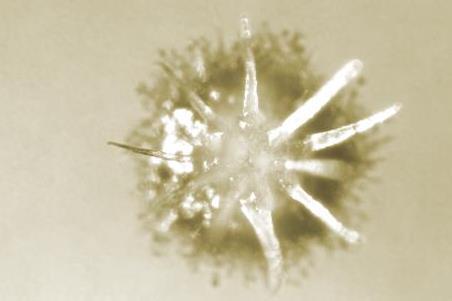The slimy outer layer of fungi and bacteria known as the ’extracellular matrix’, or ECM, has the consistency of jelly and acts as a protective and envelope layer.

But according to a recent study in the journal iScience led by the University of Massachusetts Amherst in collaboration with Worcester Polytechnic Institute, the ECM of some microbes only gels when oxalic acid or other simple acids are present.
Since the ECM plays a role in everything from antibiotic resistance to clogged plumbing and fouled medical instruments, understanding how microbes manipulate their gooey gel layers has widespread implications for our daily lives.
“I’ve always been interested in the microbial ECM,” says Barry Goodell, professor of microbiology at UMass Amherst and the paper’s senior author. “People typically understand the ECM as an inert protective outer layer that shields the microbe. But it also functions as a conduit to allow nutrients and enzymes in and out of microbial cells.”
Sticky layer
An envelope layer has a number of functions: its stickiness means that individual microbes can clump themselves together into a colony, or “biofilm,” and when enough microbes do this, it can clog pipes or contaminate medical equipment.
But the envelope layer also needs to be permeable: many microbes will secrete various enzymes and other metabolites outward through the ECM into a material they want to eat or infect - say, decaying wood or vertebrate tissue - and then, once the enzymes have done their digestive work, draw nutritious compounds back in through the ECM.
This means that the ECM isn’t simply an inert protective layer at all; in fact, as Goodell and his colleagues have shown, microbes seem to have the power to control how viscous, and thus how permeable, their ECM is.
Fine tuning the ECM
In fungi, the secret seems to be oxalic acid, a common organic acid found naturally in many plants—and, as Goodell and his colleagues discovered, many microbes appear to use oxalic acid that they secrete to combine with a carbohydrate outer layer creating a sticky, gel-like ECM.
But as the team looked closer, they discovered that the oxalic acid not only helps to create the ECM, it ‘tunes’ it: the more oxalic acid that the microbe adds to the carbohydrate-acid mix, the more viscous the ECM becomes. And the more viscous the ECM becomes, the more it can block large molecules from entering or leaving the microbe, while smaller molecules can still pass freely from the environment into the microbe and vice versa.
This finding challenges the conventional scientific understanding of how different types of compounds secreted by fungi and bacteria actually pass from those microbes into their environments.
Very small molecules
Goodell and colleagues hypothesize that in some cases the microbes may need to rely more on the secretion of very small molecules to attack the substrates or tissues that the microbes feed on or infect. This would mean that the secretion of small molecules may also play a larger role in pathogenesis if larger enzymes cannot pass through the microbial extracellular matrix.
“There seems to be a sweet spot where the microbe can control its acidic level to adapt to its specific environment by keeping some larger molecules, like enzymes, out while letting smaller molecules readily pass through the ECM,” says Goodell.
Tuning the ECM using oxalic acid may be one way that microbes can protect themselves against antimicrobial and antibiotic medications, since many of these medications are made from very large molecules. It is this tunability that may be the key to overcoming one of the major hurdles in antimicrobial drug therapies, as manipulating the ECM to make it more permeable could potentially enhance the efficacy of antibiotics and antimicrobials.
“If we can control the biosynthesis and secretion of small acids like oxalic acid in some microbes, we should also be able to control what can get into the microbe, which may allow us better treatments for a host of microbial diseases,” says Goodell.







No comments yet